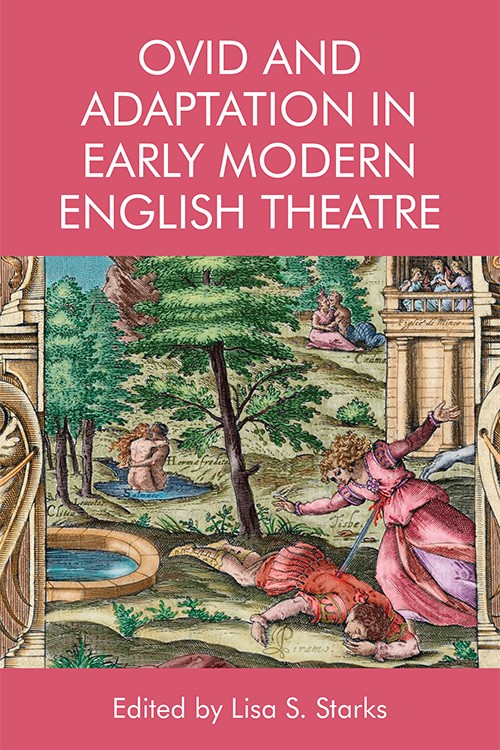
Lisa S. Starks
Introduction: Representing ‘Ovids’ on the Early Modern English Stage
I’ve always been drawn to the idea of transformation and myth, which led me to Ovid back in the 1990s. Over the years, I’ve found that Ovid’s philosophy of constant change and flux permeates early modern plays, underlying notions of theatricality and textuality. This interest has informed the two main areas of my research on Shakespeare and early modern literature: sexuality, trauma, and psychoanalysis, which I focused on in my monograph Violence, Trauma, and Virtus in Shakespeare’s Roman Poems and Plays: Transforming Ovid (Palgrave, 2014) and other essays; and Shakespearean, film, and adaptations/appropriation studies, which I’ve published on in two co-edited book collections and other essays. After leading a seminar at the Shakespeare Association of America on “Representing Ovid on the Early Modern Stage” in 2016 and speaking with participants afterwards, I considered editing a book collection on this topic. Along the way, following talks over lunch at the Folger with Goran Stanivukovic and John Garrison, I decided to give it a go. When writing the book proposal, I realized that this collection could do something quite different from other volumes: use contemporary Shakespeare and adaptation studies to analyze the multifarious, complex appropriations of Ovid in early modern English theatre. In my previous writing on Ovid, I’ve felt limited, that there was only so far I could go in examining the ways in which Shakespeare transformed Ovid to explore the traumatic effects of violence. Since then, I’ve pondered how it might be possible to open up Shakespeare and Ovid criticism and to articulate interconnections between adaptation studies and other contemporary theoretical perspectives, which this collection does. I’m extremely thankful that my brilliant contributors were all keen to take on this challenge, resulting in truly remarkable chapters on Ovid, adaptation, and early modern drama. The contributors have all shared a bit about that experience in the blog entries below:
1. Simone Chess, ‘Queer Gender Informants in Ovid and Shakespeare’
I don’t usually work with Ovid, or in adaptation studies, and yet here I am! When Lisa invited me to make a proposal for this edition, at first I was at a loss. But what I did know, and frequently teach and cite, about Ovid was about the queerer parts of the Metamorphoses, particularly the story of Iphis, which has been a core source text in the emerging canon of early modern trans studies. My research therefore developed in two directions: what were the other queer moments in Ovid’s Metamorphoses that might contextualize Iphis, and, given the influence of the Iphis narrative in queer early modern studies, how might a broader range of queer moments in Ovid be in conversation with early modern text like Shakespeare’s. My essay therefore pairs three queer Ovidian characters (Tiresias, Caenis/Caenus, and Iphis) with three Shakespearean characters (Mardian the eunuch from Antony and Cleopatra, Portia/Balthazar from Merchant of Venice, and Viola/Cesario from Twelfth Night). Though these pairings do not represent direct adaptation, they do show that Shakespeare uses Ovidian strategies when he positions his eunuch and crossdressing characters as code switchers who are especially poised to make crucial judgements and give critical insights. Thus, I find that Shakespeare — the tradition of, and seemingly in conversation with, Ovid — sometimes staged his nonbinary characters as queer gender informants whose insights and experiences add value to the plays.
2. Shannon Kelley, “Women in Trees: Adapting Ovid for John Lyly’s Love’s Metamorphosis (1589)”
In 2019, few trees remain in my Connecticut hometown that are big enough for a person to crawl inside, but they must have existed in early modern England. In King Lear, Edgar hides inside the hollow of an oak; Ariel becomes a cloven pine in The Tempest; and in The Merry Wives of Windsor, Falstaff and the wives gather near the legendary Herne’s Oak, where children emerge from a “sawpit.”Theater historians speculate that John Lyly owned a stage tree with a hollow compartment for actors to inhabit since his Elizabethan plays often feature significant roles for the plant kingdom. It was hard for me to visualize these trees until I saw old growth coastal redwoods in the Muir Woods last summer….
Read the rest of this extended blog piece on Ovid and Adaptation in Early Modern English Theatre.






